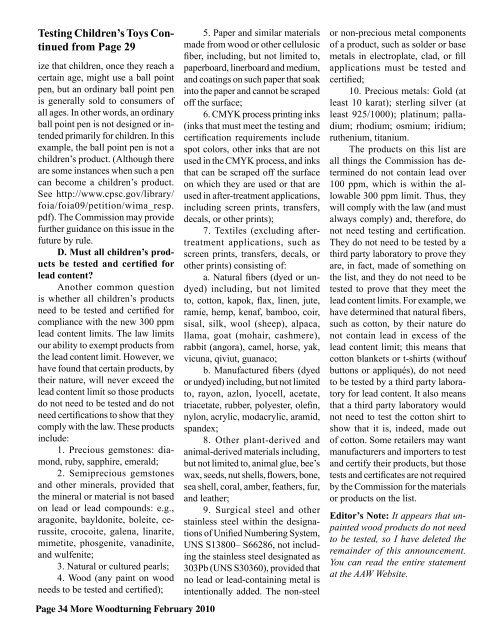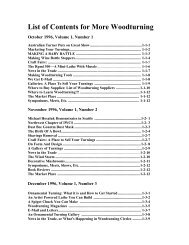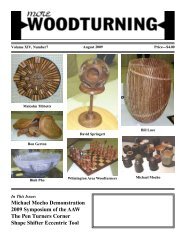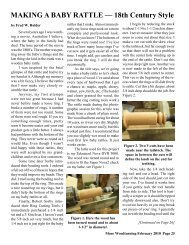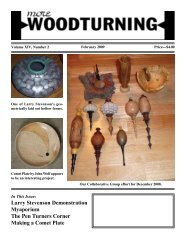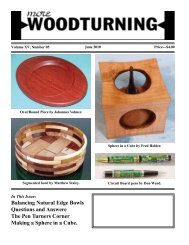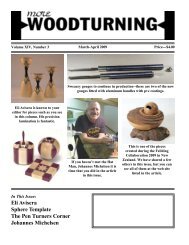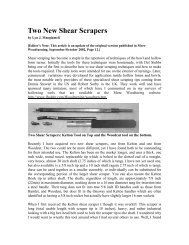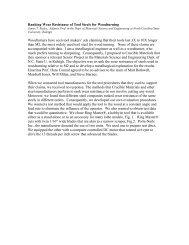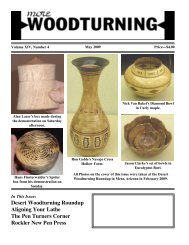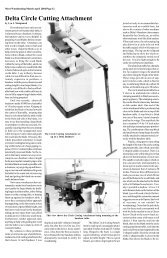Robust Lathe Review - More Woodturning
Robust Lathe Review - More Woodturning
Robust Lathe Review - More Woodturning
Create successful ePaper yourself
Turn your PDF publications into a flip-book with our unique Google optimized e-Paper software.
Testing Children’s Toys Continuedfrom Page 29ize that children, once they reach acertain age, might use a ball pointpen, but an ordinary ball point penis generally sold to consumers ofall ages. In other words, an ordinaryball point pen is not designed or intendedprimarily for children. In thisexample, the ball point pen is not achildren’s product. (Although thereare some instances when such a pencan become a children’s product.See http://www.cpsc.gov/library/foia/foia09/petition/wima_resp.pdf). The Commission may providefurther guidance on this issue in thefuture by rule.D. Must all children’s productsbe tested and certified forlead content?Another common questionis whether all children’s productsneed to be tested and certified forcompliance with the new 300 ppmlead content limits. The law limitsour ability to exempt products fromthe lead content limit. However, wehave found that certain products, bytheir nature, will never exceed thelead content limit so those productsdo not need to be tested and do notneed certifications to show that theycomply with the law. These productsinclude:1. Precious gemstones: diamond,ruby, sapphire, emerald;2. Semiprecious gemstonesand other minerals, provided thatthe mineral or material is not basedon lead or lead compounds: e.g.,aragonite, bayldonite, boleite, cerussite,crocoite, galena, linarite,mimetite, phosgenite, vanadinite,and wulfenite;3. Natural or cultured pearls;4. Wood (any paint on woodneeds to be tested and certified);Page 34 <strong>More</strong> <strong>Woodturning</strong> February 20105. Paper and similar materialsmade from wood or other cellulosicfiber, including, but not limited to,paperboard, linerboard and medium,and coatings on such paper that soakinto the paper and cannot be scrapedoff the surface;6. CMYK process printing inks(inks that must meet the testing andcertification requirements includespot colors, other inks that are notused in the CMYK process, and inksthat can be scraped off the surfaceon which they are used or that areused in after-treatment applications,including screen prints, transfers,decals, or other prints);7. Textiles (excluding aftertreatmentapplications, such asscreen prints, transfers, decals, orother prints) consisting of:a. Natural fibers (dyed or undyed)including, but not limitedto, cotton, kapok, flax, linen, jute,ramie, hemp, kenaf, bamboo, coir,sisal, silk, wool (sheep), alpaca,llama, goat (mohair, cashmere),rabbit (angora), camel, horse, yak,vicuna, qiviut, guanaco;b. Manufactured fibers (dyedor undyed) including, but not limitedto, rayon, azlon, lyocell, acetate,triacetate, rubber, polyester, olefin,nylon, acrylic, modacrylic, aramid,spandex;8. Other plant-derived andanimal-derived materials including,but not limited to, animal glue, bee’swax, seeds, nut shells, flowers, bone,sea shell, coral, amber, feathers, fur,and leather;9. Surgical steel and otherstainless steel within the designationsof Unified Numbering System,UNS S13800– S66286, not includingthe stainless steel designated as303Pb (UNS S30360), provided thatno lead or lead-containing metal isintentionally added. The non-steelor non-precious metal componentsof a product, such as solder or basemetals in electroplate, clad, or fillapplications must be tested andcertified;10. Precious metals: Gold (atleast 10 karat); sterling silver (atleast 925/1000); platinum; palladium;rhodium; osmium; iridium;ruthenium, titanium.The products on this list areall things the Commission has determineddo not contain lead over100 ppm, which is within the allowable300 ppm limit. Thus, theywill comply with the law (and mustalways comply) and, therefore, donot need testing and certification.They do not need to be tested by athird party laboratory to prove theyare, in fact, made of something onthe list, and they do not need to betested to prove that they meet thelead content limits. For example, wehave determined that natural fibers,such as cotton, by their nature donot contain lead in excess of thelead content limit; this means thatcotton blankets or t-shirts (withoutbuttons or appliqués), do not needto be tested by a third party laboratoryfor lead content. It also meansthat a third party laboratory wouldnot need to test the cotton shirt toshow that it is, indeed, made outof cotton. Some retailers may wantmanufacturers and importers to testand certify their products, but thosetests and certificates are not requiredby the Commission for the materialsor products on the list.Editor’s Note: It appears that unpaintedwood products do not needto be tested, so I have deleted theremainder of this announcement.You can read the entire statementat the AAW Website.


